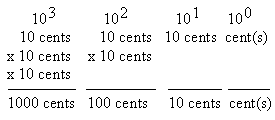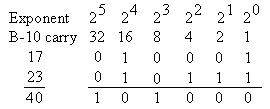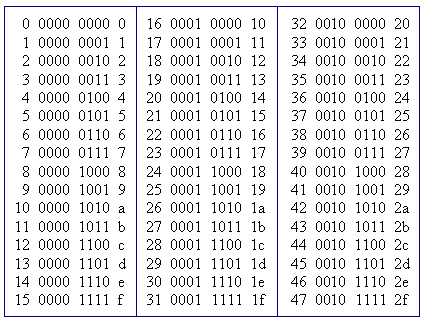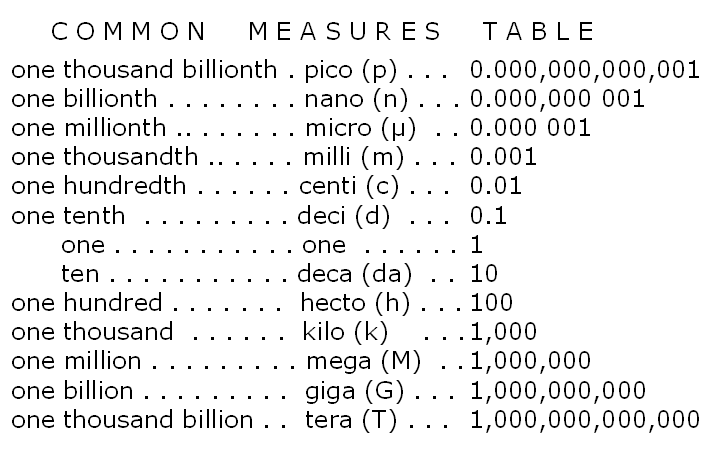Go Home
Go To Introduction
This is Book 1
Chapter 1 - Electricity
Chapter 1.2 - The Numbers
Chapter 2 - Sharing and Bonding
Chapter 3 - Voltage
Chapter 3.2 - Voltage Static
Chapter 3.3 - Batteries
Chapter 3.4 - Solar - Others
Chapter 4 - Resistance
Chapter 4.2 - Parallel Resistance
Chapter 4.3 - Voltage Dividers
Chapter 5 - Semiconductor
Chapter 5.2 - PNP NPN Junctions
Chapter 6 - Capacitor
Back To The Guide
To Book 2
Using the Numbers - Basic Algebra
In electronics, as with the rest of our lives, numbers matter.
You might hear someone say, I need two 9-volt batteries, I want
a 1500 watt portable heater, I have version 8.3 software, I need
one-forth teaspoon of pepper, lets meet for lunch at 12:30, and
so on. Numbers tell us something specific about our world.
Without numbers it would be more challenging to communicate.
In electronics this is no different.
In this section we will discuss numbers. I will address numbering
systems by their BASE number and by their system number. With that
idea in mind, we start off very slow with base-10 number system,
and then show how to jump to other numbering systems. Base-10
numbers are also called decimal numbers. So what are some of the
attributes that we know about the base-10 numbering system?
A look At Base-10 Or Decimal Number System
Base-10 numbers use these ten symbols that we call numbers
0 1 2 3 4 5 6 7 8 9
These ten symbols represent the base-10 number system.
All numbers within that system use some combination of
one or more of these symbols.
Lets start by thinking of the POWER of MONEY, which is based on the
base-10 numbering system. Looking at the illustration to the right,
the top row displays the BASE and something called an EXPONENT. This
row had 10 as the base and the exponents 3, 2, 1, and 0. In simple
terms, if the exponent is the number 0 you have what you have in the
number set. In base-10 that is the range of numbers 0 through 9. Look
at the far right-hand side of this illustration and note the 10 raised
to the power of 0. This column with exponent 0 represents the numbers
from 0 through 9 (cents in this example). The two columns with
exponents 1 and 0 can represent any two-digit combinations within the
number set. For my money chart that would be 0 to 99 cents. Column with
exponents 2, 1 and 0 represent any three-digit number combination within
the number set.
As we change from base-10 to different BASE-NUMBERS, this concept of an
exponent to a base-number will become a key in understanding numbers that
are not base-10. ONE MORE NOTE: We generally do not address what we do not
have. If I said I have $50.00 that is equivalent to $0050.00 but the two
leading zeros before the 5 are considered bad form. There is no need to
tell the reader there are no hundreds and no thousands in the number.
Even with the leading 0 being a valid number it adds no value to the
statement $50.00. However, there are times, especially in binary math,
where the 0 is handy as a place holder.
OK, time to dig in. Lets start by adding the number 123 to the number
345. In reality I am adding 100 plus 20 plus 3 plus 300 plus 40 plus 5.
In breaking this process apart, we can look at the parts, in order.
In the "ones column" 3 plus 5 is 8. 8x1= 8
In the "10 column" 2 plus 4 is 6. 6x10= 60
In the "100 column" 1 plus 3 is 4. 4x100= 400
The answer is 468
We also know something about the word CARRY. To see how this works,
replace the number 123 with the number 167 in this simple equation.
In the "ones column" 7 + 5 is 12.(carry the 1) leaving the 2
The 10-carry is too large for the 1's column and is
carried into the 10's column.
In the "10 column" 1 + 6 + 4 is 11.(carry the 1) leaving the 1
Again the 100-carry is too large for 10's column
and is carried into the 100's column.
In the "100 column" 1 + 1 + 3 is 5.(no carry) leaving the 5
The answer is 512
Base-2 The Binary Number System
Now we move into the base-2, or binary numbering system.
In base-2 the carry is used in nearly EVERY math function.
The base-10 numbering system used 0,1,2,3,4,5,6,7,8,9.
The base-2 numbers are 0 and 1. Only two symbols.
All numbers within that system use some combination of
one or more of these (symbols)numbers.
We will add the base-10 numbers 17 and 23 in base-2
after we convert them to the base-2 numbering system.
Why do we care? Because many logic operators in electronics use base-2 logic.
Consider the logical steps the eye doctor uses in selecting the
correct glasses strength.
She or he might say, looking at the eye chart, is number one
or number two clearer?
This is number ONE! This is number TWO! Again ONE! And TWO!
In electronics we want to know how to do operations based on binary
logic, like true or false, or on or off. Electronic functions can answer a questions including: Is it
dark outside, is the door open, did the car start, did somebody press
a key on the keyboard, is it warmer than 100 degrees,and so on.
Take a quick look at the chart illustration. Along the top we see the
base number is 2 and the exponent numbers are 5, 4, 3, 2, 1, and 0. We
can easily have exponents larger then 5 but for this example this is
large enough. The illustration also has a section on the left titled
B-10 Carry for base-10 with carry and numbers written below in base-10.
To the right of the number 17 is the 32s column.
17 is not equal to or larger than 32, place a 0 in that column.
Moving one column to the right to the 16s column.
17 equal to or larger than 16, place a 1 in that column,
and subtract 16 from 17, with remainder of 1. This is because the 16s
column is the placeholder for that amount of the origional number.
Moving one column to the right to the 8s column.
1 is not equal to or larger than 8, place a 0 in that column.
Same with 4s and 2s placing 0 in each of these.
1 is equal to or larger than 1, place a 1 in that column, and subtract
1 from 1, with remainder of 0, so stop.
17 in base-10 equals 010001 in base-2.
Now repeat these steps with the number 23.
To the right of the number 23 is the 32s column.
23 is not equal to or larger than 32, place a 0 in that column.
23 equal to or larger than 16, so 1, with remainder 7
7 is not equal to or larger than 8, place a 0 in that column.
7 equal to or larger than 4, so 1, with remainder 3
3 equal to or larger than 2, so 1, with remainder 1
17 equal to or larger than 16, so 1, with remainder 7
1 is equal to or larger than 1, place a 1 in that column, and
subtract 1 from 1, with remainder of 0, so stop.
23 in base-10 equals 010111 in base-2.
Starting at the far right side add numbers and the carry.
Step 1) Exponent 0 column also known as the 1s column, 1 plus 1 is 0 with carry of 1 to column 2s leaving ? ? ? ? 0 plus carry
Step 2) Exponent 1 column also known as the 2s column, 1-carry plus 0 plus 1 is 0 with carry of 1 to column 4s leaving ? ? ? ? 0 0 plus carry
Step 3) Exponent 2 column also known as the 4s column, 1-carry plus 0 plus 1 is 0 with carry of 1 to column 8s leaving ? ? ? 0 0 0 plus carry
Step 4) Exponent 3 column also known as the 8s column, 1-carry plus 0 plus 0 is 1 with NO-carry to column 16s leaving ? ? 1 0 0 0 NO carry
Step 5) Exponent 4 column also known as the 16s column, NO-carry plus 1 plus 1is 0 with carry of 1 to column 32s leaving ? 0 1 0 0 0 plus carry
Step 6) Exponent 5 column also known as the 32s column, 1-carry plus 0 plus 0 is 0 with NO-carry leaving 1 0 1 0 0 0
Converting 101000 back to base-10 by adding the 1 in the 32s column with the 1 in the 8s column gives 32 + 8 = 40 in base-10.
Hexadecimal Number - Base-16
In this illustration we will take a look at base-16 numbers. Because
our decimal number system does not have 16 symbols we need to add 6
additional symbols to the 10 we generally use.
Base-16 numbers use these symbols as numbers
0 1 2 3 4 5 6 7 8 9 a b c d e f
In base-16 also called hex and hexadecimal, all numbers within that
system use some combination of one or more of these numbers.
The table is in three sections. Starting at the top of the left
section in its far left column is the number zero. Looking two lines
below that, in the third line, it reads 2 0000 0010 2. The first number
2 is a base-10 number. The numbers 0000 0010 is a base-2 number for 2.
The last 2 is a base-16 number for 2. Moving to the last line in that
section, the line reads 15 0000 1111 f. In this line the 15 represents
the base-10 number for 15. The number set 0000 1111 is the binary number
for the same value of 15 and the f is the hexadecimal number for 15.
Note that when writing base-2 numbers it is easier to read them if they
are split is sets of 4-digits starting at the right side. For base-16
numbers, the f is the largest single digit number in that set. Now, moving
to the top line in the center column, this number represents the values for
the number 16. Review the table and notice how the base-2 and base-16 numbers
change over their number sets.
When working with mixed numbers the base needs to be written. For example
20h(hex) times 101b(binary) equals 160d(decimal).
If you add
5d = 0000 0101b
8d = 0000 1000b
7d = 0000 0111b
4d = 0000 0100b
___ _________
24d = 0001 1000b
It is easy to use a chart or a calculator to start with.
This chart has the first 48 numbers (0 is a common number in electronics)
The same number 24 as represented in base-10, is 0001 1000 in base-2 and 18 in hex(base-16)
One more bit of useful information is using a conversion table. It is
common to use letters to represent number. At the center of the table is
the 1's place. To convert form 100 pennies to 1 dollars divide by 100.
To convert a kilometer to meters multiply by 1000. A MICRO-something is
very small at one-millionth of the something. If your camera has a 5.1
megapixel rating you will have 5.1 million pixels (5100000 pixels) of
picture resolution. A tera-byte of data is one-thousand-billion bytes
of data. That is a lot.
« Previous Chapter Next Chapter »
Email us: info@shoeboxkits.com






